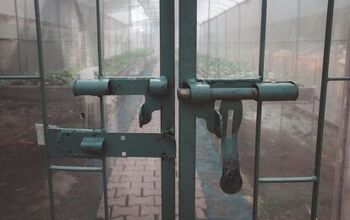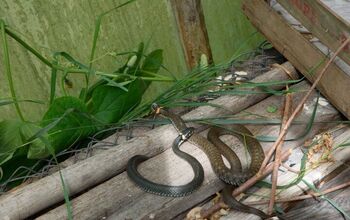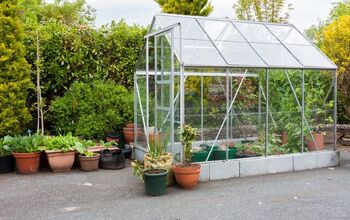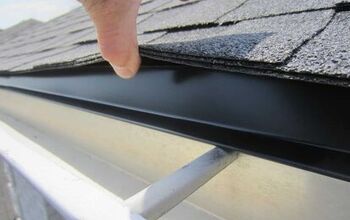How To Prepare A Greenhouse For The Winter

A greenhouse can give countless gardeners and homeowners the chance to grow their beloved plants in a controlled environment. This is invaluable for people who want to give their plants the best shot at healthy, fruitful lives. However, you’re not alone if you’ve ever wondered how to prepare a greenhouse for the winter.
To prepare a greenhouse for the winter, you must clean it, remove the dead plant matter, and sweep the soil. Next, patch the cracks and gaps with silicone sealant and tape, then insulate the walls with bubble wrap or a similar alternative. If you want to keep growing plants during the winter, you must run heaters and fans.
Some people even cover their plants to protect them from cold air in areas with harsh winters. Follow along as we explore how to prepare a greenhouse for the winter.
How To Winterize A Greenhouse
Winterizing a greenhouse is not difficult, although the process varies based on your intentions. For example, you may skip a few steps if you don’t plan to grow plants during the winter. However, most of the steps are necessary whether you want to grow plants or not, such as:
1. Thoroughly Clean It
Keeping up with greenhouse maintenance can be a hassle, but it makes winterizing your greenhouse much easier. That’s especially true if you’ve struggled with greenhouse pests, fungi, and diseases throughout the spring and summer. Some fungi and plant diseases can survive over the winter if you leave soil and plant matter in your greenhouse.
Removing the soil, plants, and organic matter can reduce that risk and make the winterizing process easier. Start on one side of the greenhouse and empty any pots and planters you don’t plan to use during the winter. Repeat this process for each section of the greenhouse before you clean the floor.
Otherwise, you’ll continually spill more soil on the floor and simply waste time. Many people leave some plants in their greenhouse over the winter, which is fine, but you must still clean the surrounding area.
2. Patch Gaps And Cracks
A greenhouse can experience lots of wear and tear throughout the year, and cracks and gaps may form by the time winter rolls around. That’s why you must carefully inspect your greenhouse before winterizing it, or the damage may worsen due to cold temperatures. Otherwise, heavy winds, cold air, rain, snow, and ice may enter the greenhouse.
Walk around the perimeter of the greenhouse, carefully inspect the walls for cracks, and take note of any damage you find. Next, move inside the greenhouse to check for loose panels, cracks, and insulation damage. Typically, you can fix most minor problems with greenhouse damage tape, foam tape, and silicone sealant.
You can even patch some cracks with a hot glue gun, but you must use your best judgment. The goal is to make your greenhouse airtight to restrict the amount of cold air that enters.
3. Re-Insulate It
You must re-insulate your greenhouse if you plan to grow some plants throughout the winter. If not, they will be vulnerable to frost damage and may die. Even if you have thermal foil or double poly foam insulation, it’s still worth adding more if you live in a cold climate.
For example, you can affordably insulate your greenhouse with bubble wrap to retain heat throughout the winter. That way, you can easily remove it in the spring, and you won’t have to spend a fortune. However, in many cases, twin-wall polycarbonate is the best way to extend the growing season as much as possible.
Insulation helps compensate for the lack of natural heat during the winter, and it can keep cold air out of your greenhouse. It’s worth insulating your greenhouse even if you don’t want to grow plants during the winter. At the very least, insulation can protect your greenhouse equipment and walls from thermal damage.
4. Heat The Space (Optional)
Have you considered how to heat your greenhouse during the winter? Naturally, this is only necessary if you plan to grow some plants in your greenhouse during this frigid season. You can only expect your plants to grow if you heat the space to at least 45 degrees Fahrenheit.
Some people keep their greenhouse temperature between 50 to 75 degrees Fahrenheit throughout the winter. The ideal temperature ultimately depends on the plants you plan to grow and the climate you live in. Electric fan heaters are the most cost-effective options, but you can also use electric radiant heaters to heat a greenhouse.
Keep in mind that you must be careful when using gas and propane heaters, as there is a greater fire hazard. Some people simply use electric radiant heaters and water barrels to heat their greenhouse during the winter. Water barrels absorb heat on sunny days and eventually release it, which can save money on heating costs.
5. Keep Up With Ventilation
Some people mistakenly believe that ventilating their greenhouse isn’t necessary during the winter, but it is essential during the cold months, as it helps evenly distribute air and warmth throughout the greenhouse. That’s especially true if you plan to grow plants in your greenhouse this upcoming winter.
Ventilation can help prevent mold, stale air, and excessive humidity, which can otherwise cause condensation. The easiest way to ventilate your greenhouse during the winter is to run at least one fan. However, it’s worth running two or three fans if you have a big greenhouse.
If you use fans, spread them out to ensure they cover enough ground and evenly circulate the air. It’s also important to open the door for up to a few hours on warm, sunny days during the winter. Doing so will help remove stale air and refresh your greenhouse.
6. Cover Your Plants (Optional)
This is another optional step, but it’s a great idea if you plan to grow plants in your greenhouse over the winter. Covering your sensitive plants can help them retain moisture and stay safe from cold, dry air at night. Doing so can also protect them from common greenhouse pests if you’ve recently noticed signs of them on your plants.
You can use something as simple as a standard tarp to protect your plants, otherwise, you can cover them with horticultural fleece, which some people prefer because of its breathability. However, some people prefer tarps because they’re less likely to suffer damage.
You can also use clear plastic wrap and bubble wrap, but you must make sure it’s not too tight against the plants. The benefit of this option is that your plants will still get sunlight without being overly exposed to cold air.
Is It Worth Growing Plants In A Greenhouse During The Winter?
It’s worth growing plants in a greenhouse during the winter, as long as you take the proper precautions. Many people prefer to not stop growing plants for several months each year in order to not start over in the spring after taking a winter break.
This is especially true for people who grow fruit and vegetables to eat and or sell. With a greenhouse, they don’t have to give up several months of growth. That alone is worth the time and effort it takes to grow plants in a greenhouse during the winter.
However, there’s also nothing wrong with winterizing and shutting down your greenhouse for the season. You should be able to bounce back quickly when spring arrives, and you can start the growing season early. A greenhouse also extends the growing season by 4-8 weeks or more, so you may not have to shut it down until mid-winter.
Summing It Up
The best way to prepare a greenhouse for the winter is to thoroughly clean it and patch the gaps and cracks in the walls. Doing so can help protect your greenhouse from mold, fungi, diseases, and pests that are otherwise hard to get rid of. You must heat, insulate, and ventilate your greenhouse if you plan to extend the growing season into the winter.
Related Guides:

Nick Durante is a professional writer with a primary focus on home improvement. When he is not writing about home improvement or taking on projects around the house, he likes to read and create art. He is always looking towards the newest trends in home improvement.
More by Nick Durante



















![10 Most Dangerous Neighborhoods in Baltimore [Updated]](https://cdn-fastly.upgradedhome.com/media/2023/07/31/9075655/10-most-dangerous-neighborhoods-in-baltimore-updated.jpg?size=350x220)







